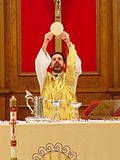- Memorial Acclamation
-
In Roman Catholic, Lutheran, and some Anglican and Methodist churches, the Memorial Acclamation is a part of the Eucharistic Prayer. It is sung or recited by the congregation.
It is most commonly used after the Words of Institution.
Contents
Form of the acclamation
In the 1973 English translation of the Roman Missal, the priest says or sings, "Let us proclaim the mystery of faith", thus inviting the congregation to recite one of the following four acclamations:
- Christ has died, Christ is risen, Christ will come again.
- Dying you destroyed our death, rising you restored our life. Lord Jesus, come in glory.
- When we eat this bread and drink this cup, we proclaim your death, Lord Jesus, until you come in glory.
- Lord, by your cross and resurrection, you have set us free. You are the Saviour of the world.
The Latin text of the Roman Missal has only the following three acclamations:
- Mortem tuam annuntiámus, Dómine, et tuam resurrectiónem confitémur, donec vénias.
- Quotiescúmque manducámus panem hunc et cálicem bíbimus, mortem tuam annuntiámus, Dómine, donec vénias.
- Salvátor mundi, salva nos, qui per crucem et resurrectiónem tuam liberásti nos.
The first English acclamation is a loose translation of the first in Latin, turning what is a prayer addressed to Jesus into a third-person statement. The second, derived from words in the first Easter Preface,[1] is an English interpolation into the text of the Missal. The third and fourth depart less from the Latin original.
In Canada each of the four English acclamations is introduced with a unique introduction:
- V: Let us proclaim the Mystery of Faith! R: Christ has died ...
- V: Praise to You, Lord Jesus, firstborn from the dead! R: Dying you destroyed our death ...
- V: We are faithful, Lord, to your command! R: When we eat this bread ...
- V: Christ is Lord of all ages! R: Lord, by your cross ...
The revised English translation of the Roman Missal, which is expected to be put into use in most English-speaking countries on the first Sunday in Advent in 2011 (it is already in use in South Africa and New Zealand) has three acclamations, each a faithful translation of the corresponding Latin acclamation:
- We proclaim your Death, O Lord, /and profess your Resurrection, /until you come again.
- When we eat this Bread and drink this Cup, /we proclaim your Death, O Lord, /until you come again.
- Save us, Savior of the world, /for by your Cross and Resurrection /you have set us free.
There is a single introductory phrase, which is simply: "The mystery of faith", corresponding to the Latin "Mysterium fidei".[2]
Other liturgies
The Tridentine Mass has no such congregational acclamation[3] and incorporates the phrase Mysterium fidei (The mystery of faith) within the Words of Institution.
The Book of Alternative Services of the Anglican Church of Canada has an acclamation, as well as some United Methodist churches. Lutherans also have an acclamation.[4] The Episcopal Church (United States) has the first form of the acclamation in it's Rite II Eucharistic Prayer in the 1979 version of the Book of Common Prayer.
Footnotes
- ^ "Bishops Defer Decision on Missal Adaptations," Adoremus, July-August 2005.
- ^ The Order of Mass
- ^ James Dallen, "The Congregation's Share in the Eucharistic Prayer," Worship, vol. 52, no. 4 (July 1978) 329-341.
- ^ Order of Worship, from Lutherans Online. Retrieved 2010-16-01.
See also
- Mass (liturgy)
- Mass (music)
- Text and rubrics of the Roman Canon
- Roman Rite
- Mass of Paul VI
- Divine Service (Lutheran)
- Eucharist
External links
Order of the Divine Service in Lutheranism Preparatory Service Entrance hymn and Trinitarian formula (known as the Invocation) · Penitential Rite including the Confiteor and Declaration of Grace (or Asperges on Easter)
The Service of the Word Introit · Gloria Patri · Kýrie · Gloria · Dominus Vobiscum · Oremus · Collect · Old Testament reading · gradual (or Responsorial Psalm) · Epistle · Alleluia (tract during Lent) · Gospel · Hymn of the day · Homily or Postil (Sermon) · Nicene Creed (Athanasian Creed on Trinity Sunday) · Offertory · Prayers of the FaithfulThe Service of the Eucharist Preface (Sursum corda / Sanctus / Hosanna) · Eucharistic Prayer (Epiclesis / Words of Institution / Memorial Acclamation) · Lord's Prayer · Sign of peace / pax (elevation) · Agnus Dei · Distribution · Nunc dimittis · Postcommunion · Benedicamus Domino · Benediction · Dismissal · Ite missa estParticipants Parts of the Sanctuary altar · altar bell · altar crucifix · altar rails · kneeler · piscina · processional cross · tabernacleCandles Liturgical vessels Liturgical objects collection basket · holy water · incense (use) · paten · sacramental bread (wafer) · sacramental wine · thuribleVestments Liturgical books and hymnals Agenda · Evangelical Lutheran Hymn-Book · Evangelical Lutheran Worship · Lutheran Book of Worship · Lutheran Hymnal · Lutheran Hymnal with Supplement · Lutheran Service Book · Lutheran Worship · Service Book and Hymnal Lutheranism PortalCategories:
Lutheranism PortalCategories:- Christian liturgy, rites, and worship services
- Structure of the Mass
- Lutheran liturgy and worship
Wikimedia Foundation. 2010.
